
The Navy Department Library
Pocket Guide to Japan
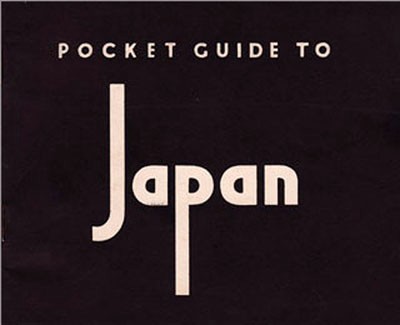
Pocket Guide to Japan
For use of Military Personnel only. Not to be republished in whole or in part, without the consent of the War Department
Prepared by
ARMY INFORMATION BRANCH, I. AND E. DIVISION, A.S.F.
UNITED STATES ARMY
FOR THE WAR AND NAVY DEPARTMENTS
We shall not rest until our enemy is completely overthrown.
We do not count anything done as long as anything remains to be done.
We are well on the way, but Japan itself is our final goal.
Out motto becomes "On To Tokyo".
May God speed the day.
Douglas MacArthur
General of the Army
(commenting on the fall of Manila, 6 February, 1945),
******
Japan deserves the concentrated attention of all our armed forces in the Pacific. One way to give the enemy attention is to find out all we can about him. This book is provided for that purpose. Other ways are by bombing his cities, sinking his shipping and destroying his factories. We are doing that. The best attention we can pay him is to invade his homeland. Every island we have taken has been a stepping stone to the Japanese Empire. In war it is not the first step but the last which count the most. On the sea and under the sea, through the air and across the land we will move together in the final step to victory.
C.W. Nimitz,
Fleet Admiral, U.S. Navy.
Contents
| PAGE | |||
| I. | The Job You've Done So Far | 1 | |
| II. | "On to Tokyo" | 3 | |
| Your Job in Japan | 3 | ||
| Who's Your Enemy in Japan? | 8 | ||
| Can You Tell What They're Thyinking? | 9 | ||
| III. | The Japanese Mind | 11 | |
| 1. Shinto (the Religion) | 12 | ||
| 2. Tenno (the Emperor) | 14 | ||
| 3. Bushido (the Way of the Warrior) | 16 | ||
| IV. | Looking Backward | 22 | |
| A Short History of Japan | 22 | ||
| Japan's Chronicle of Treachery | 25 | ||
| V. | Looking at the Country | 29 | |
| Geography of Japan | 29 | ||
| Climate | 32 | ||
| Earthquakes | 60 | ||
| Japanese Houses | 62 | ||
| Food in Japan | 63 | ||
| Japanese Women | 64 | ||
| Customs and Manners | 65 | ||
| VI. | Your Health | 70 | |
| VII. | Conclusion | 77 | |
| VIII. | Annexes and Various Aids | 80 | |
| Currency, Weights, and Measures | 80 | ||
| Language Guide | 85 | ||
--iii--
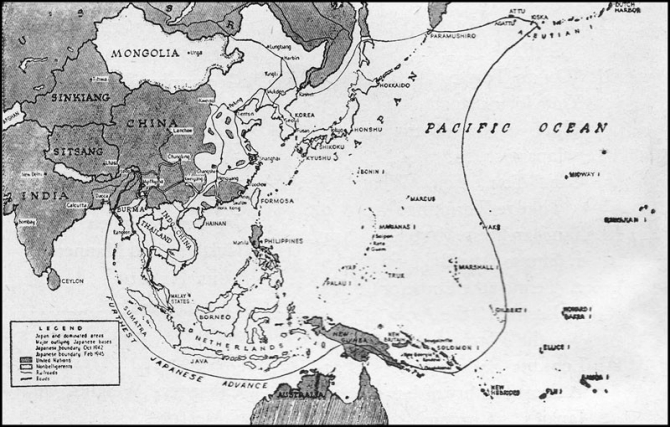
--iv--
I. The Job You've Done So Far
The United States is going into Japan's home islands.
That very fact is proof that the Allied forces have done one of the greatest jobs in military history.
What does this mean? What was necessary for the fighting men of America to do in order to reach this point?
To refresh your memory, take a look at the map which shows the hold Japan had in the Pacific and the Far East back in 1942.
This has been a new kind of war - one in which campaigns were fought for strategic little islands in a vast ocean. We had to blast the Japanese defenders out, isle by island, yard by yard. And after each place fell, another would loom up across hundreds of ocean miles.
--1--
But with this kind of fighting, we have hammered the Japs back over 3,000 miles, measuring from Guadalcanal toward Japan. That distance is not so important as mileage as it is a tribute to the American men who gave their lives to win it. The going has been tough beyond description, but the job has been well done.
The extent of the job our forces have done is impressive, even on a map. But beyond that, the fighting man of America knows how impressive it is in terms of sweat and blood and fighting and sacrifice. And your country knows, too.
What this means to the future of America, your family, and yourself can be measured only in your imagination. Ask yourself this.
"What would have happened if Japan had won the war?"
--2--
II. "ON TO TOKYO"
Your Job in Japan:
The late President of the United States said that Japan will be occupied, whether she surrenders before we land on her soil or not. The Japs are not going to be let off lightly any more than the Germans are this time. During the last 26 years the Germans have taught us how a soft peace pays off. We are not going to make the same mistake again. The Japs cannot escape occupation the way most of Germany did in the last war. They are going to be taught a lesson they will never forget.
We are going to make it impossible for Japan to go to war again - she must be made to realize that peace can bring greater rewards than war.
The United States armed forces will fight their way to Japan and occupy
--3--
her home islands. The chances are you will fight your way in. Or maybe you will march in after Japan surrenders. At any rate, if you do go there, you will have a responsible job.
The presence of the American fighting man in Japan will help to deflate the Japanese of their cock-eyed ideas that they were born to rule the world. It will help to show them that they are not the master race in Asia or anywhere else. It will show them that their dreams of invincibility were sheer nonsense and that their mission during the last 80 years was anything but divine.
Remember that this is the American way.
"We come as conquerors but not as oppressors."
Take that as your motto. Make it the key to your conduct.
You must not fraternize with the Japanese. Do not make friends.
You will not associate with Japs on friendly or intimate terms, either in public or in private. As a nation they have committed crimes against civilization which cannot be written off the books with a phoney play of friendship.
These are the people who slaughtered the American soldiers you grew up with, trained with, and fought beside.
--4--
These are the people who murdered the Doolittle fliers forced down in Japanese occupied territory.
They raped, pillaged, and murdered in a city that had already fallen - the Chinese city of Nanking.
They tortured, starved, and killed the prisoners of Bataan and Corregidor.
They are not your friends.
Do not kid yourself.
They are your enemies and they hate everything about you.
You will not visit Japaneses homes. It is not likely that you will be asked to because the Japaneses seldom ask foreigners into their homes. In peacetime they are a courteous people but they are not hospitable. They are a clever, scheming people who will try to make trouble for you in every way they can. They will lie openly and without conscience. They will think nothing of it if the end justifies the means. For your own good, do not let them get you mixed up innocently in any of their plots or scheming.
Though you must not fraternize, you should not go too far in being tough. Your conduct should be strictly American - upright, civilized, and decent.
You will not discuss with the Japanese the future of Japan. What is to be done with the Japs after surrender is not for the individual soldier to
--5--
decide. Your job is that of a guard. It is not for you alone to determine the future of Japan, or what is to be done with the Emperor and the Japanese Government.
Stay out of Japanese temples and shrines. If, in the line of your official duties, it is necessary for you to go into one of their temples or shrines, that is different. Otherwise, steer clear of them.
You should be an example not only for the Japanese but for all the peoples of Asia who will judge America by your behavior in Japan. Their eyes are focused on you; and remember, 1 billion people live in Asia - over half the world's population. They will have a lot to do with tomorrow.
The Japanese will be inquisitive. They are the most inquisitive people on earth. They will notice everything about you; your appearance, your equipment, your behavior. They will ask questions. Some of them may be merely curious about America and American ways, but many of them will be trying to find out anything that might be valuable to them. Every scrap of information they can squeeze out of you will be reported by them to a higher authority. Do not think they won't turn it against you if they can.
We learned something about Jap inquisitiveness when we found out why
--6--
little men dressed as tourists, fishermen, and laborers were going around photographing the shore lines, harbors, and military installations of the United States before the war. Those photographs went to Tokyo and became a part of Japan's great G-2 collection of information on the United States. It was to be used when they attacked our mainland - but their plan didn't come off.
Many Japanese will approach you to practice a few words of English. A good rule is to keep your mouth shut unless you have something to say to them in line of duty. Do not talk loosely. Say what you have to say and no more.
When you give instructions, see that they are carried out. It is one thing in Japan to give an order. It is another thing to have it carried out. You will have to check and recheck to see that your official orders to the Japanese are obeyed. The Japs are bad about this, even in peacetime and among themselves. Don't argue with them. They are great debaters. Tell them what you want done and then see that it is done. Do not accept lame excuses. They will have a thousand of them ready for you. They don't expect you to believe them. As a matter of fact, they don't believe each other's excuses, but they accept them. Life in Japan is one long excuse.
--7--
You must be strict and business-like, so that the Japanese will have no doubt that you mean what you say.
Who's Your Enemy in Japan?
As far as you know, practically everyone in Japan will be your enemy. Whether they show it or not, you may expect the Japs to be hostile almost to the last man, woman, or child. They lived in their islands like hermits until 74 years ago when the feudal system was done away with and foreigners were admitted into the country. The Japs called the first foreigners "red-bearded devils." They are still called that in out-of-the-way places. In recent years the Japs have been taught to hate Americans and you may expect the majority of them to have learned that lesson well. They have been told that this war was brought upon them by western greed, that the evil western powers wanted to enslave Asia for their own benefit. Of course, you know that is a lie, but that is what they were told and they believe it.
Tojo, who led Japan to war, explained that the western nations were trying to encircle Japan and draw a noose tight around her neck - to strangle her. That was the warlords' excuse for Pearl Harbor and what followed.
As it turned out, Japan put the noose around her own neck.
--8--
Among your worst enemies in Japan will be many causes of sickness and disease. They may be even more dangerous to you than the people, and they are important enough to be given a full chapter later in this booklet. (See page 70.)
Obviously in order to run a country with as many people in it as Japan we will eventually need help from the natives. Somewhere among the Japanese there must be people who can be trusted some day - people who realize that the future of their country depends on peace and proper leadership. It is not your job to find them now. So far as the people of Japan are concerned, all of them are your enemies for the present. Leave it to other agencies of the Government to determine who are going to be the good ones.
Can You Tell What They're Thinking?
The Japanese have always been taught to conceal their feelings. It is a part of their disregard for the individual and his rights, his feelings and his life. They do not show pain. They do not show joy. They are poker-faced.
For this reason, you can't tell what is going on in the mind of the grinning, bowing little man you will meet in Japan.
Behind his smile and his courtesy may be a plan to kill you.
--9--
Centuries of training and self-discipline have taught the Japs to conceal on the surface the things that are going on in their minds.
Knowing this might save your life.
Don't be fooled by actions which might be a front for something designed to destroy you.
--10--
III. THE JAPANESE MIND
You will never fully understand the way the Japanese think or do things today because in almost every way our ideas are exactly opposite to theirs and, as a result, our actions are too.
But the Japanese brain is made of the same kind of material as any other human brain. Their screwy thinking is the result of a diseased idea - an idea resulting from generations of deliberate training.
The peace-loving nations of the world must cure the Japanese habit of mind which is dangerous to peace and the rights of other peoples.
In time, the Japanese nation can be taught to think that other people have rights. If you don't think any Japanese people can believe in democracy and freedom, check the great fighting record of the 100th Infantry Battalion,
--11--
United States Army. It's all made up of American citizens of Japanese ancestry. Its soldiers think right according to Americans, and very wrong according to the Germans they left buried in the mud of Italy.
Three main factors have more to do than anything else with the strange ideas and actions of the enemy Japs. These three influences have been bearing down on the lives of the people of Japan for so long that finally they have shaped the personality of the nation.
They are:
1. Shinto (the Religion)
Shinto is the national religion of Japan. It is not the only religion which has existed in Japan - including Buddhism and Christianity - but it has had the greatest influence on the nation.
To begin with, Shinto was based on worship of nature - the birds and the bees, trees, flowers, rocks, mountains, waterfalls. This original type of Shinto still exists. However, in the course of recent history the warlords and politicians moved in on Shinto and developed State Shinto, which is the enforced state religion of all Japanese today.
Under State Shinto, which is ancestor worship twisted to fit a scheme
--12--
of slavery and conquest, the Emperor is divine. He worships the Sun Goddess and the Imperial ancestors. The rest of the nation worships the Imperial ancestors as well as their own ancestors. Both Imperial and common ancestors are linked together in the Japanese mind. The Emperor is head of the national family. They think he is heaven-descended. All Japanese, in a large sense, lay claim to descent from god-ancestors, and are thus all distantly related to the Emperor.
State Shinto teaches that "Imperial blood runs in the veins of all Japanese who have thus become kinsmen, descended from a common ancestor: the Sun Goddess."
Two other principles of State Shinto are: (1) That Japan is the land of the Gods; that, as such, it is a sacred land. The rest of the world was made much later than Japan out of sea water and mud; and (2) that Japan has a sacred mission on earth - the mission of saving the world. Hence the Japanese slogan, "the whole world under one roof," and the belief that the world must accept and submit to the leadership of Japan.
Perhaps the most serious thing about State Shinto from our point of view is the belief that Jap soldiers killed in battle become protective gods who watch over the homeland. They are enshrined in the Yasukuni shrine
--13--
in Tokyo, where their names are listed on little tablets. The Emperor himself worships at the Yasukuni shrine.
Knowing this about the religion of Japan, it is easier to understand why Jap soldiers don't expect to return when they go off to war and why they are so willing to be killed in battle.
2. Tenno (The Emperor)
To the Japanese the Emperor is sacred. He is a demigod. They call him "Tenno Heika," the "heavenly king." He is never referred to by name, but merely as the "Tenno." In fact, the people mention the Emperor only rarely, and then in whispers. That is because he is considered sacred above everything else.
A modern Japanese version describes the relations between the Emperor and the people as follows:
"They may be likened to those between the trunk and branches of a gigantic tree. If we were to trace the genealogy of each Japanese subject we should find that he belongs to a family which centuries ago was either a direct or indirect offshoot of the Imperial family."
Prince Ito who wrote Japan's constitution said of the Emperor:
--14--
"The sacred throne was established at the time when the heavens and earth became separated." In Japan that means when the universe was founded, because it is supposed that earth and heaven were separated in the beginning. He continued:
"The Emperor is heaven-descended, divine and sacred; he is preeminent above all his subjects. He must be reverenced and is inviolable. He has indeed to pay due respect to the law, but the law has no power to hold him accountable to it. Not only shall there be no irreverence for the Emperor's person, but also shall he not be made a topic of derogatory comment nor one of discussion."
Ito wrote those lines 50 years ago but the Japanese people have clung to his teaching. Ever since, the war lords have used the Emperor to promote their own schemes of conquest. He has been their tool. They have used him to stir the Japanese people to new heights of fanaticism.
To sum up, to the Japanese, the Emperor is a demigod, as well as their political ruler. He is religion and politics in one. No one can stand above him or look down on him. When he passes through the streets, blinds must be tightly drawn on all windows above the first floor. He cannot be imitated. Only the imperial family may own a maroon car. No one can
--15--
touch him. All things emanate from the Emperor - the crops, life, victory. It is in the name of the Emperor that Japan set out to bring "peace, enlightenment, truth, justice, and coprosperity" to the rest of the world.
3. Bushido (the Way of the Warrior)
After defeat the Japs will be vengeful. That is part of their code of behavior. It is a code handed down from feudal times. It is known by the one word: "Bushido."
"Bushido" is a word known to every Japanese boy from the time he is old enough to toddle. Literally, "Bushido" means "the way of the warrior."
It is a code based on tradition and legend. There is no actual written formula for it but it stresses loyalty above all else - loyalty to a master. In feudal times it was loyalty to a feudal lord who was the big boss. In modern times the war lords have focused "Bushido" on loyalty to the Emperor. It is a one-sided code which calls for loyalty and sacrifice on the part of the underdog but puts no corresponding obligation on the master. Under "Bushido" the little fellow pays. The Japanese don't believe that loyalty begins at the top.
"Bushido" taught its followers to keep cool, and not to draw a sword
--16--
except to use it. The old version taught not to hit an opponent when he is down, but the Japs have discarded that part of it as obsolete.
Under the "Bushido Code," deceit and treachery are perfectly permissible, if they are employed to achieve a desirable end.
When France was knocked out of the war by Germany, the Japs didn't hesitate to walk into Indo-China across France's prostrate body. The Japs didn't see anything wrong about Mussolini's stab in the back of France.
Remember this always in Japan and never let it slip your mind.
Above all, "Bushido" teaches the Japanese never to rest until vengeance is achieved. It seems certain that millions of Japanese will follow this law of "Bushido," because they've had it hammered into their heads for centuries and they don't forget easily.
The Japs will try to avenge their defeat in every way they can.
This means they will be ready to murder American soldiers whenever they get the chance. Don't give them that chance. Be careful. They will not think of the consequences to themselves. As "Bushido" has taught them, they will be ready and willing to sacrifice themselves in this business of vengeance. Maybe this sounds fantastic to you but you can't afford to take chances. The enemy Japanese are fantastic people.
--17--
Take one chance with them and you might wind up with a knife in your back.
When Japan has been whipped, her armies will be disbanded. But that doesn't make any difference, so far as the danger is concerned, because 80 percent of Japan's fighting men were farmers or sons of farmers. They have been saturated with the principles of "Bushido." When they return to the farms and put on civilian clothes they can be just as dangerous as they were in uniform, because they will be under cover.
This means that you will have to be extra-careful when you go out into the country. Peaceful-looking farmers may attack you. Don't go for a walk in the country by yourself. You may get carried back.
Many of Japan's demobilized soldiers may become what are known in Japan as "ronin." Loosely, "ronin" means "wanderers." They will be very dangerous wanderers.
At critical moments in Japanese history, "ronin" have spread throughout the country. Many hundred years ago, in feudal times, they were warriors without a feudal lord. Often they were men whose masters had been killed. They roamed the country and terrorized the people. They drew their long swords with the least excuse and used them effectively. If they
--18--
got the idea that someone was their enemy, or the enemy of their former feudal master, they cut him up.
The "ronin" were out for vengeance, just as the Japanese soldiers after this war will be out to avenge their defeat.
The strange part about it is that these outlaws were honored and respected by the people they terrorized. They have even been glorified in the pages of Japanese history, as well as in songs and literature.
The classic example of how "Bushido" works is to be found in the famous "Tale of the Forty-seven Ronin". The story is familiar to every Jap. He considers it a perfect example of the way he would act. It is told to the smallest children by their fathers.
The story is about a feudal lord named Asano, who was in attendance on the Shogun. The Shogun was the big chief - the ruler who stole the Emperor's powers.
Another feudal lord named Kira insulted Asano. This happened in the Shogun's palace but Asano drew his sword and went to work on Kira, without killing him.
A private brawl in the palace could not be tolerated, so when the Shogun heard of it he ordered Asano to kill himself by committing harakiri the
--19--
same evening. Asano followed instructions. Afterward, his castle was confiscated, his family declared extinct, and his followers were disbanded. They became "ronin."
Asano's 47 "ronin" scattered all over the country. They took small jobs here and there to avoid suspicion but all the time they were plotting and scheming.
Suddenly, on a snowy night 2 years later, they joined in an attack on Kira's mansion. This time the job on Kira was complete. The "ronin" carried his head through the streets to the temple yard where Asano was buried and set it up on their master's grave. For doing this they were ordered to commit harakiri. They also followed instructions and were buried in the same temple yard as their master. Their graves in Tokyo have since been honored as national monuments. That's the difference between the way we regard gangsters and the way they do.
This is a lesson in what the Japs think is chivalry. But you too can learn a lesson from it: the Japs are vengeful to an extreme; the Japs consider this sort of business patriotic; they are crafty and will plot patiently.
The Japs care nothing at all for their own lives. That is what makes them so dangerous.
--20--
Nowadays daggers are the Japs' favorite weapons. Long swords have gone out of use except in battle. These short daggers are often carried hidden in the sleeves of kimonos.
All Japs are potentially dangerous - young or old, male or female. The old people were born close to the feudal age and have feudal ideas. The young have been trained and indoctrinated by the Army.
The Japanese approve of assassination if the motive is patriotic. During recent years, three Jap Premiers were targets of assassins. Yet none of the assassins drew more punishment than a few years in jail. None of them was executed because each claimed his motive was patriotic. Actually the assassins were hot-heads sponsored by the militarists.
Figure this one out.
Admiral Okada, who was Premier in 1936, was discredited because he missed being assassinated. Military rebels went out gunning for him but made the mistake of shooting his brother-in-law, who looked like him. Okada, a slick operator, escaped from his official residence as a mourner at what was supposed to be his own funeral. He lost face with the Japanese because he saved himself without having any patriotic motive for doing it.
--21--
IV. LOOKING BACKWARD
A Short History of Japan
The Japs claim the oldest history of the world, which, according to them, goes back 2,605 years. They consider it unique. In fact, it is upon this claim of being unique and better than anyone else that the Japs have built their dreams of conquest - of conquering the whole world. Germany got into trouble the same way.
Japanese history and mythology are one, although the Japs call it all history. Most of it is just one long fairy-tale. The great majority of them fall for it completely though, because they think it is sacred. Their history is sacred; their Emperor is sacred; their soil is sacred. There is no end to this business of things being sacred in Japan. That is what has given
--22--
the Japs the outrageous superiority complex that makes them want to dominate Asia and the rest of the world.
Their first Emperor, Jimmu, who is said to have ascended the throne 660 years before Christ, boasted:
"We shall found the Empire and cover the whole of that which is under the heavens." The Japs have been trying to make that boast good.
The Japanese claim to be descended from the Sun Goddess, "Amaterasu." The story goes that she sent her grandson to earth to rule Japan. She gave him a mirror said to be her reflection. This sacred mirror, as it is called, is said to be kept in the grand shrine of Ise, near the city of Nagoya.
Japanese history consists of a whole series of internal feuds. For centuries the Japs warred among themselves. The kingdom was closed to the outside world. For almost 300 years before American Commodore Perry opened up Japan, the Japs had set their emperor aside. They didn't throw him out, they simply sidetracked him, and the Shoguns - military dictators - did the ruling.
Commodore Perry sailed into Yedo Bay - now Tokyo Bay - on July 8, 1853, with his famous black ships. He wanted to trade with Japan. It will interest you to know that another of Commodore Perry's main
--23--
purposes was to make the Japanese accord humane treatment to United States sailors shipwrecked on the shores of Japan. Before Perry's visit to Japan the Japanese had been brutally mistreating and murdering such sailors. The Japs didn't wait until this war to use such methods. Perry did not use force but he was prepared to if necessary. After long negotiations, the Japs agreed to open certain ports to foreign ships and commerce. The impact of Perry's visit put an end to the Shogunate and the Emperor was restored to power as a source of authority. The feudal clans were abolished and Japan turned her face westward.
It was not long, however, before the Japs turned from internal wars to making wars on their neighbors. Japan fought two major wars: one with China in 1894-95; and the other with Russia in 1904-05.
In the war with China the Japs grabbed Formosa, the Pescadores, and the Liaotung peninsula at the southern tip of Manchuria. They made China give up Korea.
In the war with Russia Japan strengthened her hold over Korea which she later annexed, seized the Russian railway in Manchuria, and the southern half of Sakhalin Island.
When Japan defeated Russia, a Western Power, her appetite was
--24--
sharpened for more. The French have a saying: "Appetite comes by eating." That fits the Japs perfectly, just as it fitted their European partners, the Germans. The more territory they swallowed, the more they wanted.
Here are some of the fantastic and cocky ideas the Japs have revered as part of their history:
That Japan is a divine land of the gods.
That this makes the Japanese superior to anyone else.
That ancestral spirits guard their land.
That they have a divine mission to conquer the rest of the world.
Japan's Chronicle of Treachery
The Japs are a treacherous people. They approve of treachery and consider it an instrument of war.
In 1904 the Japs struck at Russia suddenly without a declaration of war. Three Jap destroyer squadrons attacked the Russian fleet in Port Arthur without warning, sinking two Russian battleships and a cruiser.
In 1931 the Japs struck at Mukden during the night and in a few days had overrun most of Manchuria - again without warning and without a declaration of war.
--25--
On December 7, 1941, came the attack at Pearl Harbor, while Jap diplomats were at that very moment talking "peace" in Washington.
This is a chronicle of treachery equalled by no other nation in modern times, with the possible exception of Germany. It is the stab in the back method which is typical of the Japanese. It isn't new. It runs all through their history.
Japan's plan for world conquest was set forth in a famous document known as the Tanaka memorial.
General Baron Tanaka, its author, was Premier in 1927 when he drew up the plan and presented it to the Japanese Emperor, Hirohito. The Chinese got hold of the document and published it 2 years later. It was such a brazen plan that no one at the time seriously believed the Japs meant what Tanaka said they did. The Japs claimed it was a forgery, but anyhow events have since proved that the document and Japan's intentions confirm one another, even if Tanaka didn't live to see Japan carry it out.
Tanaka demanded a policy of "blood and iron."
He outlined his program as follows:
"If we want to control China, we must first crush the United States, just as in the past we had to fight in the Russo-Japanese war.
--26--
"But in order to conquer China, we must first conquer Manchuria and Mongolia. In order to conquer the world, we must first conquer China. If we succeed in conquering China, the rest of the Asiatic countries and the South Sea countries will fear us and surrender to us. Then the world will realize that Eastern Asia is ours and will not dare to violate our rights.
"The way to gain actual rights in Manchuria and Mongolia is to use this region as a base and under the pretense of trade and commerce penetrate the rest of China. Armed by the rights already secured, we shall seize the resources all over the country. Having China's entire resources at our disposal we shall proceed to conquer India, the Archipelago, Asia Minor, Central Asia and even Europe."
The Japs tried to carry out Tanaka's plan to the letter. But what they did not reckon with in their "superman" idea and their belief in their divine superiority was that the United States was a stronger country than they could crush. The swagger, the chestiness, the conceit of the Japanese war lords knew no limit. The more they raved, the more they thought they could get away with.
The Japs were the first to defy the world after the last war, by their conquest of Manchuria. When Mussolini and Hitler followed suit with
--27--
their aggressions in Europe, the Japs gained new courage to grab more. Piecemeal they infiltrated everywhere in Asia. Finally they struck at Pearl Harbor in a crazy gamble for world power. That was the beginning of the end of Japan as a first-class power. Her own treachery backfired on her.
For centuries the Japanese have been kidded into the belief that their conquest of the world was a patriotic and divine mission. They have planned and schemed for it. They all believe it. It wasn't the Japanese army or navy that stabbed us in the back at Pearl Harbor. It was the Japanese nation - the same nation that fouled Russia in 1904 and China in 1931 - a nation moulded by fanatical beliefs dangerous to the rest of the world.
Remember this strange twist of the Japanese national mind:
Because the Japanese have talked themselves into thinking their conquest was patriotic and divine, they can see nothing wrong with the lying, cheating, murder, and rape they have practiced in carrying it out.
What we think is decent, and count on in other people we deal with, means nothing to the Japanese. His notion of honor is entirely different from yours.
--28--
V. LOOKING AT THE COUNTRY
Geography of Japan
The homeland of Japan consists of four main islands: the island of Honshu, which is the central island; to the south the islands of Shikoku and Kyushu, which are separated from the main island by the famous Inland Sea of Japan, known for its scenic beauty; and to the north the island of Hokkaido, which is separated from the main island by a narrow strip of water.
Altogether the area of the Japanese islands is about 148,000 square miles. In that small area, about the size of the State of California, lived 73,000,000 Japanese before the war. The main impression you will get when you land in Japan is that the country is cramped and crowded. Everything is in
--29--
miniature - the hills, the valleys, the farms, the houses. If you are accustomed to the big open spaces of America, you will feel more or less shut in.
There is no land to spare. What open spaces there are left cannot be cultivated. Only 16 percent - less than one-sixth - of the land can be cultivated and it is used to the last inch. The rest is barren lava rock and forest land.
The most prominent landmark in Japan is Mount Fuji-san (Fuji-yama). San means mountain - so does yama. It makes no difference whether you call it Fuji-san or Fuji-yama. However, it will be designated on official maps as Fuji-san. It is easy to remember Fuji's height. It is 12,365 feet. All you have to do is think of the 12 months in the year and the 365 days. Fuji's snow-capped peak is visible from Tokyo. It is like a cone. It is a favorite subject of Japanese artists and poets.
According to Japanese legend, Fuji arose in a single night, while Lake Biwa near Kyoto sank at the same time. Actually Fuji is now an extinct volcano. The bump on one side, close to the summit, was formed in the last eruption of 1708.
If you are ever tempted to climb Fuji, you will find it a stiff climb. A Japanese poet has said of Fuji: "The mountain which I found higher to
--30--
climb than I had heard, than I had thought, than I had seen - was Fuji's peak."
The Japanese have a proverb: "He who fails to climb Fuji in his lifetime is a fool; he who climbs it twice is a bigger fool."
The principal farm products in Japan in the order of their value are rice, tubers, wheat, fresh vegetables, fruit, beans, tobacco, and tea. Rice paddies are everywhere in the valleys and terraced along the foothills; mulberry grows in the gorges and up the mountain slopes; tea bushes are terraced in the foothills.
In Japan cross-country walking is more difficult than at home. The rice paddies in the lowlands and the thick mulberry plantations confine the people to the roads and paths. However, in the hills and mountains, you can cut across country as we would in the Adirondacks or the Smokies.
Many Americans think of Japan as a land of cherry blossoms, painted tea cups, giggling damsels, and Mount Fuji. This is the story-book and fairytale version. It is not the twentieth century reality.
In reality Japan is an industrial country. She is short in raw materials. She lacks oil, iron ore, and coking coal at home, but she has imported these essentials and used them to build up a powerful war machine. Japanese
--31--
factories have been hidden away from the public gaze, but they have been producing day and night for years past, so that Japan could set out on the conquering path. The leading industrial areas are in the Tokyo-Yokohama, Nagoya, and the Osaka-Kobe-Kyoto areas of Honshu Island, and the northern part of Kyushu. Tokyo, in type of product, compares to Detroit.
Climate
There are extremes of climate in the islands of Japan. In the central island, in and around Tokyo, the climate is very much like that of Washington, D. C. Tokyo winters are moderate with an occasional snowfall but the snow lasts only a day or two. In the northern part of the main island, which is, for the most part, mountainous, the winters are severe. On the western side snow piles up several feet high and the natives go in for skiing. In the Kinki district, centering about Kyoto, Kobe, and Osaka, the winters are milder than in Tokyo and snow is rare. Hokkaido is quite like New England.
The most notable part about the Japanese climate is what is called the "nyubai" or rainy season. The official date is from June 11 to July 3. Actually it comes very close to those dates. During that 3 weeks period, it
--32--
rains off and on daily. It is generally a constant drizzle with a mist lying low over the ground. The humidity is high. Clothes, books, cigarettes, and other articles mildew unless they are put away in tins.
When the "nyubai" is over, the heat sets in. The temperature in Tokyo in summer varies between 85° F. and 98°. Usually it remains in the high nineties throughout the latter part of July and August. The most unpleasant part about it is the humidity and the fact that the heat is pretty constant. It doesn't come in waves as it does back home. It is steadily hot throughout the 2 summer months.
In the late summer and fall there are typhoons. These generally work their way up from the Philippines or the central Pacific by way of the Bonin Islands. Japan is visited every year by four or five of these typhoons, some of which are destructive.
If you get caught in a typhoon, try to find a good substantial building and stay indoors. Japanese frame and paper houses are often blown down, but no big stone building has ever been destroyed in a Japanese typhoon. Even at its worst, a typhoon is not as destructive in Japan as a tornado back home. A typhoon generally lasts from 4 to 8 hours. As the storm
Continued on page 60
--33--
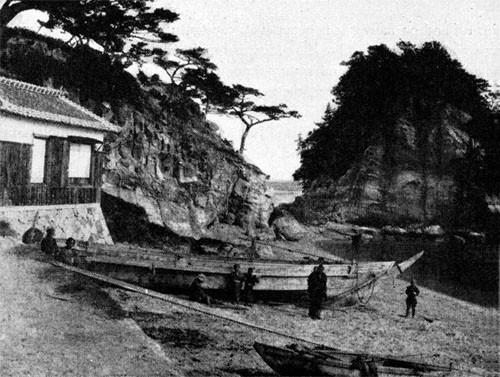
--34--
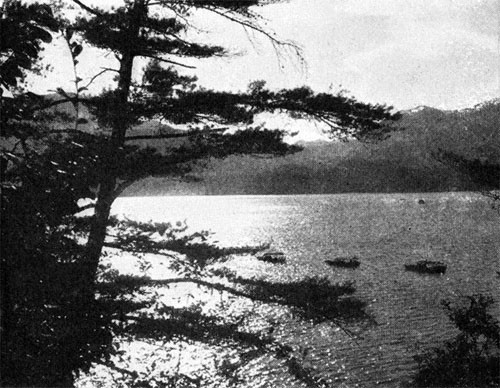
--35--
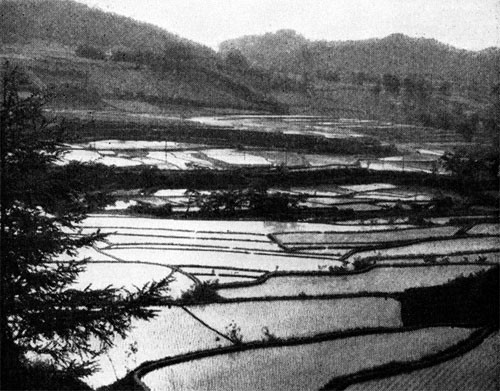
--36--
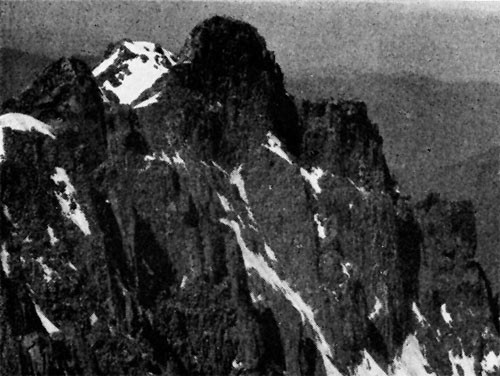
--37--
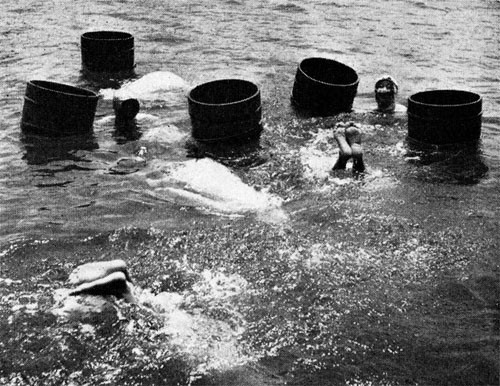
--38--
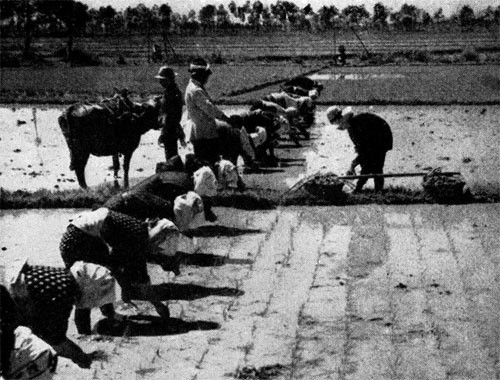
--39--
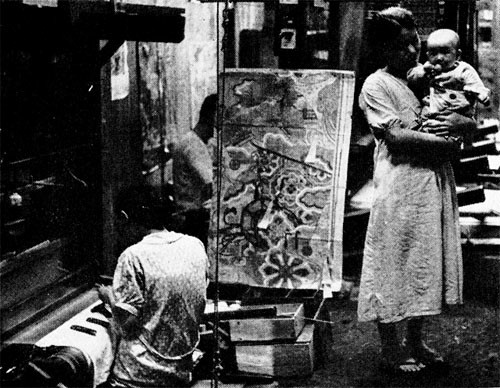
--40--
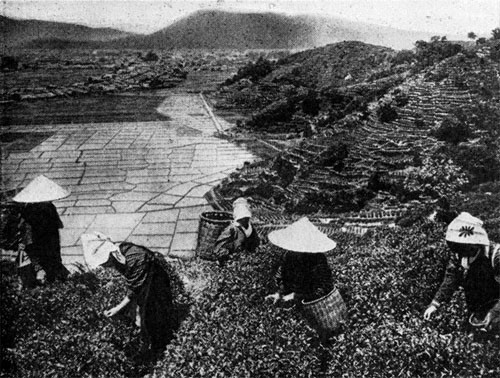
--41--
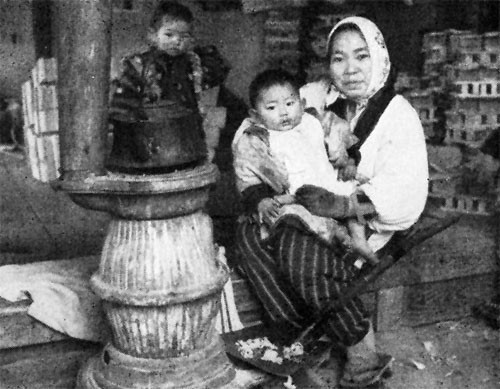
--42--
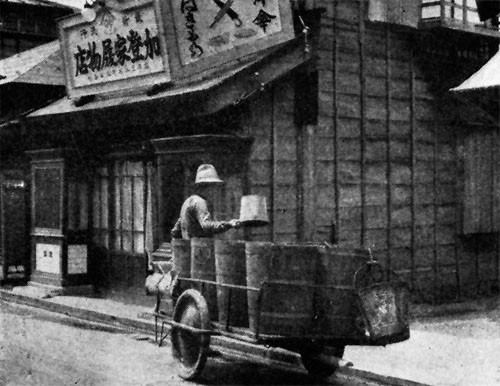
--43--
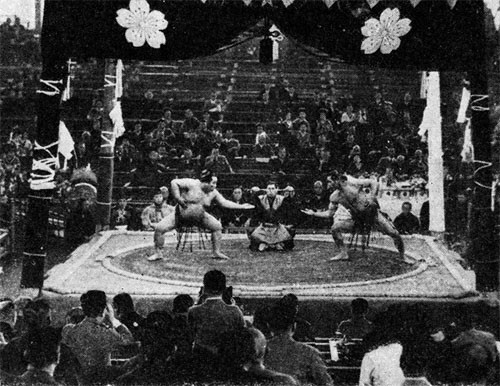
--44--
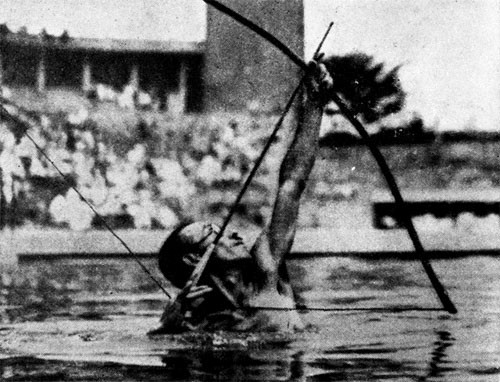
--45--
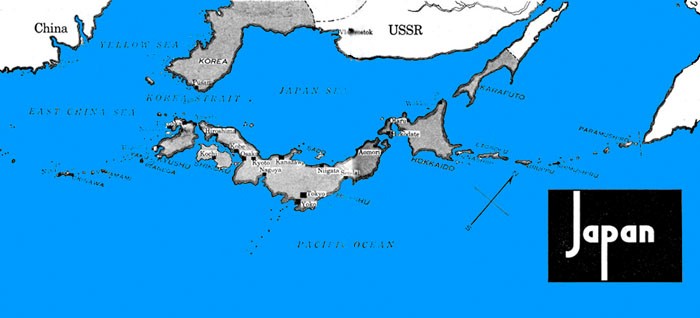
--46/47--
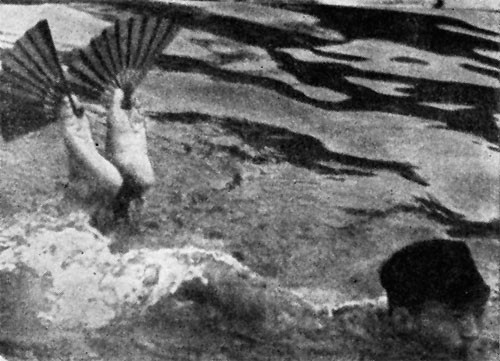
--48--
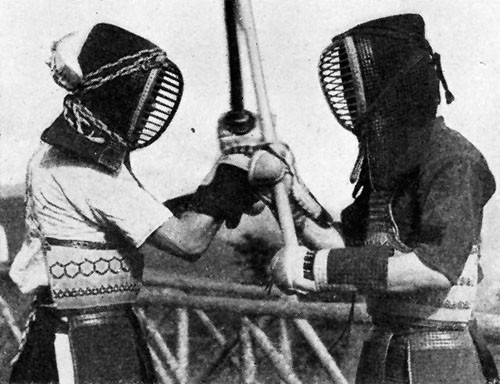
--49--
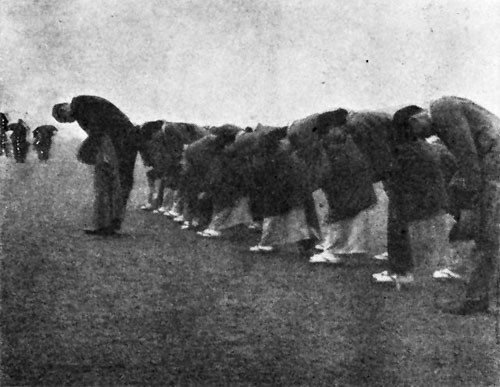
--50--
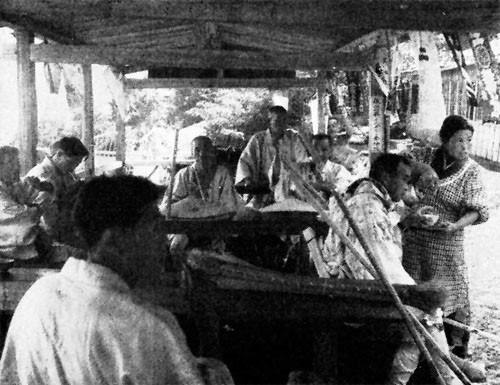
--51--
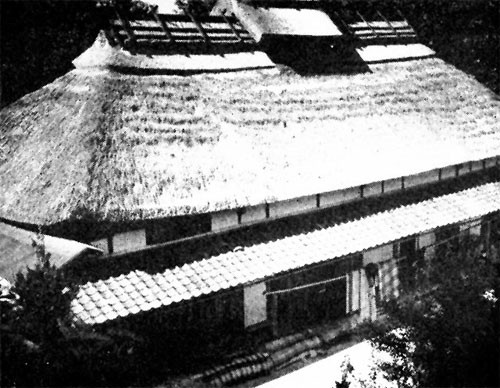
--52--
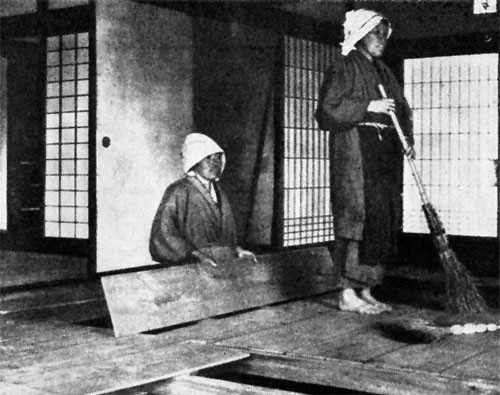
--53--
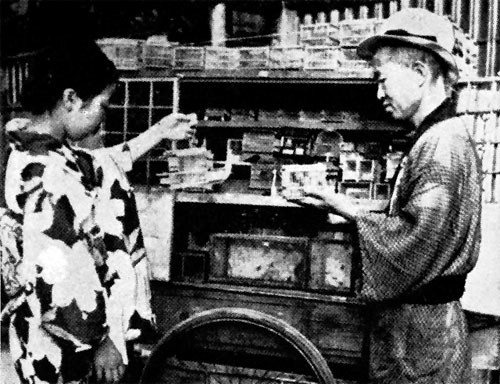
--54--
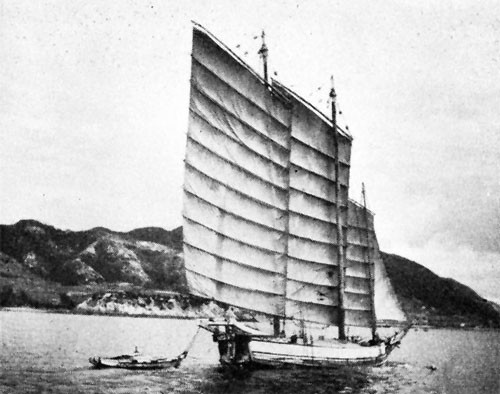
--55--
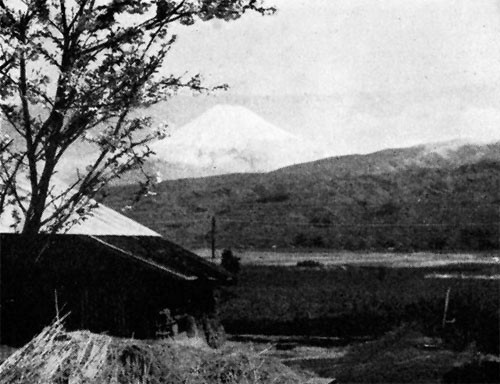
--56--
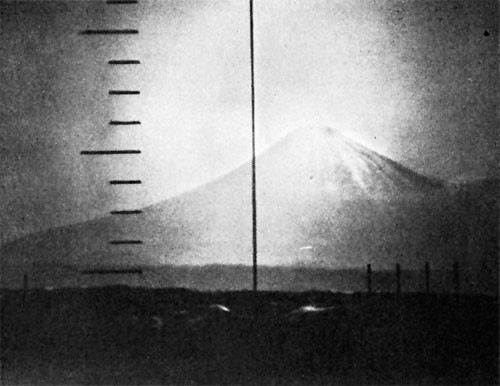
--57--
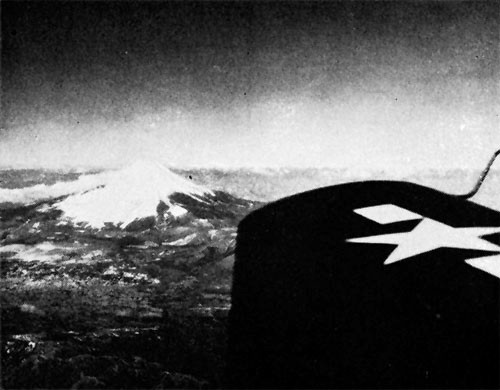
--57--
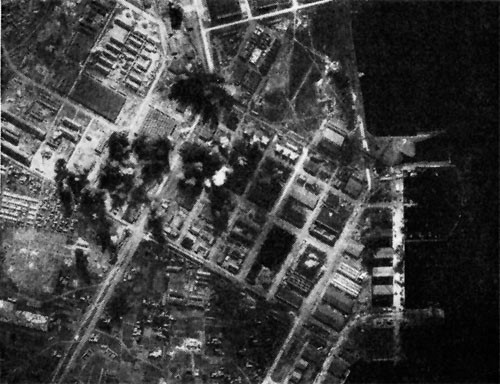
--59--
Continued from page 33
center approaches, it increases in intensity and then it dies down after the center has passed. If you are caught in the very center of a typhoon, which is extremely unlikely, you will experience a complete lull in the midst of the storm. Don't interpret this as the end of the storm.
Earthquakes
Japan is a land of earthquakes. Actually, minor shocks are recorded almost daily on sensitive seismographs, but you will feel them only occasionally. You may average an earthquake once in 2 weeks. Really severe ones occur at intervals of from 10 to 30 years. Tokyo and Yokohama were virtually wiped out by a great earthquake on September 1, 1923.
Of course you never know whether an earthquake is going to be a bad one or not. At first you may be amused but after you have been in Japan a while and the novelty wears off you won't be amused any longer, particularly if you have ever seen what a bad earthquake can do. The Japs dread them. They call them "jishin."
Here is some good general advice about earthquakes:
If you are indoors and if the earthquake comes at night, jump out of bed, open your door, and stand under the doorway. The cross-piece above
--60--
the doorway is supposed to protect you. That is to say, if the ceiling caves in, you have a better chance not to be hit. There is another reason for opening your door. It may jam during an earthquake and you might not be able to get out afterwards. Earthquakes often lead to fires and you want to make sure you can get out. You may also hold a pillow over your head to protect you from falling plaster and other debris.
Some people crawl under the bed during an earthquake. The idea is that if the ceiling caves in it will not fall directly on you. This is good only if you are in a bungalow or if you are on the ground floor. The best idea is to stand under a doorway.
If you have time - and the chances are you won't - you may run out into the street. But if you do, run far out into the middle of the street. Don't stand close to a house. Even in a minor earthquake, a tile may slide off a roof and hit you on the head or a chimney may topple over on you.
Don't wait around to see how bad the earthquake is going to be. Act in a hurry. Earthquakes often start gently and then suddenly get worse.
You will soon learn that there are two kinds of earthquakes. The shocks may be horizontal or vertical. The horizontal ones are less dangerous. The houses will sway and the chances are they won't collapse. The
--61--
really dangerous earthquakes are the vertical ones. They give a sudden lurch and are very destructive.
Earthquakes last only a few seconds or minutes. Most of the time they are over before you have done very much about it. One other piece of advice: in winter don't rush out into the street without clothing if you happen to be in bed or in a bathtub when a minor earthquake strikes. The chances of catching cold are greater than the chances of a serious earthquake. Only one earthquake in many hundred is catastrophic.
Japanese Houses
You have heard that the Japs live in frame and paper houses. This is no fairy tale. The vast majority of them do.
Most Jap homes are bungalows or at most two-story frame houses. There are no foundations. The house simply sits on the ground. The main pillars are of wood and the walls of mud or plaster in the cities. The roofs in towns or cities are generally of tiles. In the country they are often thatched roofs, of thick straw.
There are few walls in a Jap house. The remaining partitions are made of sliding doors - known as "shoji." They are frame doors covered
--62--
generally with a thin rice paper. In better homes in the cities, they may be glass doors. The floors are made of wood covered by straw matting.
Japs sleep on the floor. That is why they are particular about keeping the matting clean. They lie on a thin mattress and cover themselves with a quilt. A hard block serves as a pillow. It may be wood or porcelain. It catches them in the neck and not behind the head. Some Japs now use pillows, but these are generally small and hard.
It is the easiest thing in the world for a Jap to hide in his house. Generally the boards of flooring are removable and there are large empty spaces under them. This is because the pipes and electric wiring run between the boards, and mechanics, plumbers, and electricians have to get under when something goes wrong.
Warning: Any Jap can hide under these boards. The matting is put back on the floor and you would never know where the hiding place is.
Food in Japan
Of course, you won't be eating in Japanese homes, but it might interest you to know something of Japanese eating habits.
The Japs eat little. Their main food is rice: Rice for breakfast, rice for
--63--
lunch and again rice for dinner. Some Japs eat as many as 15 bowls of rice a day. From this unbalanced diet they sometimes get beri-beri.
Here is an average Jap menu for the day:
Breakfast: Boiled rice (actually it is steamed rice); bean paste soup; pickles. The pickles are pretty important.
Lunch: Boiled rice; boiled vegetables; possibly dried fish, bean-curd or an egg.
Dinner: Clear soup, sashimi (sliced raw fish), or broiled fish; chawan-mushi (steamed egg custard - a very popular and common dish); rice again; and pickles again.
There are, of course, many variations. There are numberless dishes or foods that are consumed in restaurants and public eating places. They are essentially party food. Among such dishes the best known are sukiyaki (beef stew) or torinabe (chicken stew). There is also ebi tempura (fried prawns) and a variety of sea food.
Japanese Women
The outstanding characteristics of Jap women is that they stay in the background. Man is their master - in the home and in business too. Women
--64--
have always held an inferior position in Japan. Their position had improved slightly before Japan went on the warpath in Manchuria 14 years ago. But since then war has glorified men to such an extent that the women have been shoved to the back seat again.
Japanese women are little more than servants. They have two jobs: (1) To serve the master in the home; and (2) to bear children - preferably sons, not daughters.
Don't ever forget this: Jap women are just as treacherous as the men. They will plot and scheme too. They too will be reckless with their lives. Don't trust them any more than you do the men. They will act as decoys.
You are not to associate with Jap women.
Customs and Manners
You will want to learn something about Japanese customs and manners. Some of them will puzzle you. To anyone from the western world life in the Orient is strange and new. Knowing something of this life and the customs of the people is not only interesting but in some cases it's important on the basis of personal safety.
For example, in Japan the Emperor is sacred. You won't subscribe to
--65--
that belief and you needn't let the people think you do. Still, there is no use going out of the way to impress the Japanese with your disbelief. Some fanatic might be sufficiently insulted by such an action to feel it his obligation to kill you.
The Jap Emperor's crest is a 16-petal chrysanthemum. You will soon learn to recognize it when you see it. It really looks like a daisy with 16 petals but the Japanese call it a chrysanthemum. You will see it often on temples and shrines. Don't make fun of it or deface it. It is sacred to the Japs. This is what it looks like:

The same thing applies to the crest of the Empress. Hers is a paulownia leaf and flower. The flower consists of three upstanding shoots. It looks like a wisteria turned upside down.
The Japanese have a custom of taking off their shoes when they enter
--66--
a house. Of course, you won't have to worry about this, because whenever you go into a Jap house it will be on official business, in line of duty and under arms. But it is interesting to know that going into a Jap house with your shoes on is like entering an American house with your hat on, only much worse because the Japanese eat and sleep on the floor. In the United States we take off our hats. In Japan they take off their shoes.
Men come first in Japan. When a family walks in the streets, or anywhere else, the husband - master of the house - comes first; then the oldest son, then other sons if any; then the wife and daughters. The man goes ahead, the woman follows carrying the bundles. It looks like a chow line with the women bringing up the rear. In Japan, chivalry is backwards.
The Japanese bow frequently. When a Jap meets another of the same social level - an acquaintance, friend, or relative - he bows. Both bow over and over again until they succeed in raising their heads at the very same moment. This is to show that the two are social equals for a lower bow on either side would indicate a lower social level. Servants and employees, of course, bow lower to their masters or employers than the latter do.
If a Japanese hisses at you he is not giving you the bird. He does this
--67--
to express appreciation. It is a sucking-in of the breath to show appreciation of some courtesy or deference. A Jap speaking to a policeman, for instance, or to some high official, will hiss and bow continuously.
Mothers and children carry babies strapped to their backs in Japan. It is one of the reasons for the high infant mortality rate there. Children of 7 or 8 years of age will carry their younger brothers or sisters strapped to their backs and will run around playing this way. If they stumble, the baby may be smothered or injured and often is. A Japanese couple will consider themselves lucky if they raise three out of five children to maturity. It is particularly tragic when the casualties are boy babies, because in Japan boys are far more valuable than girls.
Another Japanese custom which is not accepted in America is the practice of belching. It is perfectly polite for a Japanese to show his appreciation for a good meal by giving forth with a loud and lusty belch.
A Jap infected with erysipelas may go to a Christian hospital and be refused admission because erysipelas is an infectious disease which should, according to American standards, be treated in isolation. However, he would not be admitted to a Japanese isolation hospital because erysipelas has never been declared infectious by the Sanitary Bureau of the Home Ministry.
--68--
Where else but in Japan would you see a Japanese gentleman riding in a crowded railway carriage dressed only in his spectacles and a G-string? In America this would be a good way to get in both the papers and the clink. But it's nothing to get excited about in Japan.
These are some of the things that make us realize the strange differences between our way of thinking and that of the Japanese.
--69--
VI. YOUR HEALTH
Public sanitation in Japan is not all that it should be. It does not in any way compare with that in the United States. Modern facilities for the treatment of water and the disposal of sewage are found only in the large city areas. Even the newer parts of Japanese cities, which are well planned, are surrounded by slums, crowded, filthy, and crawling with vermin.
Even though the water supply is abundant, and even though there are many public filtering and chlorination plants, don't trust the water. Drinking bad water is one of the best ways to knock yourself out. So far as you are concerned, the only safe rule is to drink officially approved water and no other. If you don't follow this rule, you may wind up with typhoid, paratyphoid, or one of many intestinal diseases.
--70--
Contaminated food is another very common cause of disease in Japan.
In America it is customary to use the excrement of cattle and horses for fertilizer. The Japanese carry this a step further and use that of human beings for the same purpose. This is dangerous, because fruits and vegetables fertilized in this way are likely to be contaminated. For this reason, in Japan you should not eat improperly prepared raw fruit or vegetables. The smart thing to do is to let the mess sergeant be your only source of such foods.
The Japs have several ways of preparing raw fish, and some of these dishes taste pretty good. Stay away from them, though. Japanese fish and seafoods may be contaminated with germs, or they may contain tapeworms and flukes which can cause serious sickness. All fish and seafood dishes must be thoroughly cooked before you eat them. If you want to be absolutely safe, don't eat any place in Japan unless it has the OK of the Medical Department.
Lice, fleas, and mites spread a lot of disease in Japan. Rats and other small animals carry these insects which can be just as deadly as a Jap bayonet. Typhus is one of the most common diseases spread in this way.
Diseases spread by lice are particularly common in the rural areas and
--71--
colder mountain districts. In such areas it's smart to play safe and dust your clothing with DDT powder as a preventive measure. Don't get lousy; stay away from infested areas; keep your body clean.
Another dangerous insect is the common housefly, which carries typhoid, paratyphoid, amoebic dysentery, cholera, and other intestinal diseases. Flies do this mainly by splitting their time between latrines and kitchens. This means you must keep flies away from your food.
As for snakes, the only poisonous snake in Japan is the "mamushi" which is a form of viper found in damp, muddy places. Its bite may kill you. Except for this one, you don't have to worry much about snakes in Japan.
In Japan venereal diseases are prevalent - syphilis, gonorrhea, chancroid and lymphogranuloma venereum. Prostitution is a thriving business in Japan. It is licensed and controlled by the police. But don't let that fool you. Japanese prostitutes are almost universally infected with venereal disease. In addition to the government regulated houses and districts there is another form of tolerated prostitution, by waitresses in small drinking places and certain types of tea houses, as well as by low-class geishas in rural districts.
The best rule in Japan is a rule that makes sense anywhere: Keep away from prostitutes and pick-ups. That is the best way to keep from getting
--72--
a venereal disease. The next best way is to use prophylaxis properly and promptly.
There are a lot of diseases common to Japan which you are not likely to find in the United States. Most of them have big names which don't mean anything to the average person. But regardless of names, they are all tough and painful. These are some of the most common diseases in the area around Japan.
Schistosomiasis. This disease is caused by blood worms. There is a lot of it in Japan. The parasite which causes it is carried by certain types of fresh-water snails. For the most part the infection is limited to the rural population, mostly rice farmers and boatmen. However, under combat conditions American troops will be exposed to this disease. You can get it from wading, bathing, washing clothes or vehicles, or drinking water which is contaminated. The worm parasite which causes the disease is so small that it cannot be seen without a microscope. Any surface bodies of fresh water such as ponds, lakes, streams, or rivers, in areas where the infection is prevalent should be considered sources of picking up this infection. Salt water is safe from this disease and ocean swimming is permissible because the tiny snails which carry these little worms cannot live
--73--
in salt water. Don't make the foolish mistake of bathing in salt water and then rinsing off in fresh water.
Scrub Typhus. The Japs call it tsu-tsu-gam-oo-shi. This disease is prevalent mainly in the northwest part of the island of Honshu. It is spread by mites or "chiggers" which live in the grass-covered, river-flooded areas. To prevent scrub typhus you must keep your body well covered at all times. That is, keep your sleeves rolled down, your shirt and collar buttoned - and be sure to have your leggings on when you enter one of these mite-infested areas. Your clothing and blankets should be impregnated with mite-killing chemicals (Quartermaster designation: Repellent, insect, clothing treatment). It is particularly dangerous to lie or sit down on grass or rotten logs in an area which is infested with mites. You should not stuff your pillow or mattress with grass, because the grass may be full of these disease-spreading mites.
Typhoid and Paratyphoid Fever. The low level of Japanese sanitation is largely responsible for the spreading of these diseases, as well as several forms of serious dysentery. Bad water, flies, the use of human excrement as fertilizer are the most common causes. In Japan, water discipline is a must - whether you approve of it or not. All water, even that from a
--74--
municipal source, is unsafe and should be used only after it has been boiled or properly treated. Don't drink any water unless it has been approved by the Medical Department. If you are separated from your unit supply of water, be sure to use your water purification tablets, in accordance with instructions. All native fruits and vegetables should be considered unsafe and should be thoroughly cooked or soaked in a germicidal solution before you eat them. Another thing: stay away from native dairy products, such as milk or cheese. They may tempt you but eating them could mean weeks or months in the hospital.
Trachoma. This is an eye disease which often causes blindness. There is a lot of it in Japan. Usually it is spread by the use of infected articles. Keep clean - particularly your hands. Be especially careful around natives who have eye discharges.
Malaria. You will find malaria in almost all parts of Japan. Wear all your clothing, keep your sleeves rolled down, your shirt buttoned and use your bed net. Atabrine, of course, is a must. Take it as prescribed by your local commander. Make use of mosquito repellents issued to you. They are good insurance against malaria. The same precautions which apply to malaria will work also to keep you from getting other mosquito-
--75--
carried diseases, such as filariasis, dengue fever, and Japanese encephalitis (a brain disease).
Your health in Japan can be maintained at a high level if you remember always to practice the sanitary rules which every good soldier knows.
A booby trap may be a flea-ridden dog, a swarm of flies, a stream of polluted water, or a poisoned drink. Any of them can be as fatal as a knife in your back. Be careful, be alert, keep clean.
Remember you are in enemy country. Not all your enemies are human.
Stay in fighting trim.
--76--
VII. CONCLUSION
This booklet includes many don'ts.
There are two main reasons for this.
In the first place, you are in enemy country and are in personal danger. You are among hostile people who would like nothing better than to see you dead. They tried their best to make you that way. They will plot and scheme against you and will do anything to avenge their defeat. Their history, their background, their warrior code teach them vengeance. You know they are fanatics who carry their ideas to crazy heights.
Secondly, the price your country has paid in suffering, in dead and wounded, in time, in every way, for the defeat of the Axis, is one of the greatest prices that has ever been paid in history. It could never be figured
--77--
in dollars and cents. It is high beyond the imagination of any man. Even so, it can be a good investment if it means that Germany and Japan will never again be permitted to fight wars of aggression against peaceful, decent nations. We must be jealous of the peace we bought and the price we paid for it. Your conduct in Japan, your behavior and your attitude will help to determine whether or not the expenditure was a sound one. America will be judged in Asia by your conduct. Don't do anything that will hurt the peace you have fought for and paid such a price to win.
By doing your job so well you have become an important national figure. You can't get away from it any more than you can change the color of your eyes. Your responsibility as an important part of your nation is now a part of you. Don't try to shake it. Accept it and appreciate it.
You have become a strong part of America.
America is more a part of you than ever before.
The Japanese are an industrious, ingenious, hard-working, ambitious people. But they have turned their talents to evil rather than good. Instead of building themselves a respectable place on the level of the decent people in the world, they have chosen to defy and outrage the world by their gangster behavior. They tried to enslave all of Asia, believing
--78--
themselves superior beings with a destiny to rule and conquer others. Their defeat doesn't mean they are reformed. It simply means that they lacked the physical strength to infest the world with their barbarism and their brutality. Defeat hasn't purified them yet. They are still your enemies. Their reform will come later.
While you are in Japan conduct yourself according to the best American standards. Be fair but also be firm, because the Jap military mind which has dominated the country will understand only one language - the language of firmness.
Japan will not be occupied always. The Allies' interest in Japan is to fix it so that the Japanese can never again become a menace to the whole world.
This war must not have been fought in vain.
--79--
VIII. ANNEXES AND VARIOUS AIDS
Currency, Weights, and Measures
Japanese money. - The basic unit of currency in Japan is the Japanese yen which in 1941 was equal to 23.4 United States cents. This yen is divided into 100 sen and the sen is divided into 10 rin. The rin, however, is seldom used as a coin, but is used in quoting prices.
The following are the most common coins:
| Coin | Metal | Approximate size in terms of U. S. coins |
| 50 sen | Silver | Quarter. |
| 20 sen | Silver | Dime. |
| 10 sen | Aluminum | Nickel. |
| 10 sen | Nickel | Nickel (hole in center). |
| 5 sen | Aluminum | Dime. |
| 5 sen | Copper-Nickel | Dime, but thicker (hole in center). |
| 1 sen | Aluminum | Smaller than a dime. |
| 1 sen | Copper | Quarter. |
In 1938, aluminum coins replaced nickel and copper coins. Later all metal coins were being retired and may have been entirely replaced by paper notes of the same denomination.
--80--
Paper money is issued in 200, 100, 50, 20, 10, 5, and 1 yen notes as well as in small denomination notes of 50 sen, 20 sen, and 10 sen. The numerals for the respective values are printed on the bills. Bills are issued only by the Bank of Japan which is the sole bank of issue for Japan.
The following table gives the prewar conversion rate of the different Japanese coins and bills into approximate U. S. values:
| Coin or bill | Approximate U.S. value1 |
Coin or bill | Approximate U.S. value1 |
|
| 200 yen | $46.80. | 1 yen | 23.4 cents. | |
| 100 yen | $23.40. | 50 sen coin | 12 cents. | |
| 50 yen | $11.70. | 20 sen coin | 5 cents. | |
| 20 yen | $4.68. | 10 sen coin | 2 cents. | |
| 10 yen | $2.34. | 5 sen coin | 1.1 cents. | |
| 5 yen | $1.17. | 1 sen coin | 0.2 cent. |
1 Present free market value of Japanese currency probably is very much less than the last prewar equivalent given above.
--81--
Japanese weights and measures. Japan officially adopted the metric system of weights and measures in 1924. Consequently, all official institutions, such as government offices and railroads, as well as larger commercial establishments and stores use this system. The names of units in Japanese are the same as in English, but the pronunciation is somewhat different, especially since the letter "l" which does not exist in the Japanese vocabulary is pronounced as "r". Thus "kilogram" is pronounced KEEROGRAMMU; "kilometer" as KEEROMAYTAH; "kilolitre" as KEEROREETAH; etc. Merchants and many other Japanese are also familiar with the American system of weights and measures but will pronounce "pound" as PONDO, "yard" as YAHDO, and "foot" as HOOTO. The general public, however, did not take well to the metric system and consequently Japanese weights and measures are still predominantly used in local transactions. The following are the most commonly used Japanese weights and measures:
--82--
| Length | |
|---|---|
| Japanese term | U. S. equivalent |
| 1 Ri (ree) = 36 Cho (cho) | 2.44 statute miles. |
| 1 Cho (cho) = 60 Ken (ken) | 119.3 yards. |
| 1 Ken (ken) = 6 Shaku (shya-koo) | 1.99 yards. |
| 1 Shaku (shya-koo) = 10 Sun (soon) | 99 feet. |
| 1 Sun (soon) = 10 Bu (boo) | 1.19 inches. |
| 1 Bu (boo) | 119 inches.
|
| 1 Shaku of cloth measure equals 1.24 feet. | |
| Area | |
| Japanese term | U. S. equivalent |
| 1 Cho (cho) = 10 Tan (tahn) | 2.45 acres. |
| 1 Tan (tahn) = 300 Bu (boo) or Tsubo (tsoo-bo) | .245 acres. |
| 1 Bu (boo) or Tsubo (Tsoo-bo) | 3.95 yards. |
| 1 Bu or Tsubo is a square each side of which is 6 Shaku long. |
--83--
| Capacity | |
|---|---|
| Japanese term | U. S. equivalent |
| 1 Koku (ko-koo) = 10 To (toe) | 5.119 bushels or 47.65 gallons. |
| 1 To (toe) = 10 Sho (sho) | 4.76 gallons. |
| 1 Sho (sho) = 10 Go (go) | 1.9 quarts. |
| 1 Go (go) | 38 pints. |
| 1 Koku (ship's capacity) = 1/10 ton. | |
| 1 Koku (timber) = 10 cubic feet. | |
| Weights | |
| Japanese term | U. S. equivalent |
| 1 Kwan or Kan (kahn) = 1,000 momme (moam-may) | 8.27 lbs. av. |
| 1 Momme (moam-may) = 10 Fun (foon) | 0.13 oz. av. |
| 1 Fun (foon) | 5.79 grains. |
| 1 Kin (keen) = 160 momme (moam-may) | 1.32 lbs. av. |
| 1 Koku (fish) = 40 Kan | 33 lbs. av. (approx.). |
--84--
Language guide
JAPANESE is spoken by over 70 million people in Japan and is understood by many people in Korea and Formosa.
This Guide contains the Japanese words and expressions you are most likely to need. In the column headed Pronunciation all the words are written in a spelling which you read like English. Each letter or combination of letters is used for the sound it normally represents in English and it always stands for the same sound. Thus "oo" is always to be read as in too, boot, tooth, roost, never as in blood or door.
Syllables that are accented, that is, pronounced louder than others, are written in capitals. However, you will notice that the accent in Japanese is not as strong as in English, and that some of the syllables that come ahead of the accented syllable may sound almost as loud as the accented syllable. Curved lines( ˘ ) are used to show sounds that are pronounced together without any break; for example, "gˆyoon-yoo" meaning "milk."
| COMMANDS. | |
| English | Pronunciation |
| Wait here! | ko-ko-day Ma-tay. |
| Stand up! | TA-tay. |
--85--
| English | Pronunciation |
| Come forward! | chka-yo-ray. |
| Quickly! | HA-ya-koo. |
| Right away! | SOO-goo-nee. |
| Move back! | AHT-o-ay SA-ray. |
| Turn around! | OO-shee-ro moo-KAY. |
| Go ahead! | mahss-SOO-goo- nee yoo-KAY. |
| Follow me! | TSOO-ee-tay KOO-ee. |
| Go slow! | yook-KOO-ree ah-ROO-kay. |
| Hurry! | ee-SO-gay. |
| Don't shoot! | OO-tsoo-na. |
| Stop! or Halt! | toam-ah-RAY. |
| Who is there? | DA-rek-ah. |
| Advance | soo-soo-MA. |
| Identify yourself! | MEE-boon SHO-may-ee-sho o mee-SAY-ro! |
| Don't move! | oo-GO-koo na! |
| Surrender! | KO-SAHN shee-RO! |
| Throw down your arms! | BOO-kee o stay-RO! |
| Raise your hands! | TAY o ah-gay-RO! |
| Line up! | na-ra-BAY. |
| here! | ko-ko-AY. |
| there! | ah-sko-AY! |
--86--
| English | Pronunciation |
| Don't try any tricks! | tsoo-ma-RA-na-ee ma-NAY o soo-ROO na. |
| Obey or I'll fire! | kee-ka-NA-eet-o OO-tsoo-zo. |
| EMERGENCY EXPRESSIONS. | |
| Do you understand? | wa-KA-ree MA-ska. |
| Yes | HA-e. |
| No | EE-A. |
| I don't understand | wa-KA-ree ma-SE. |
| Speak slowly! (command) | yook-KOO-ree ha-NA-say. |
| Say it again! (command) | mo-ee-cheed-o ee-YAY. |
| Are there soldiers near here? | chee-KA-koo nee hay-ee-TA-ee ga ee-MA-ska? |
| Where are they? | DOAK-o-nee ee-MA-ska. |
| Where are American soldiers? | ah-may-ree-ka no hay-ee-TA-ee wa DOAK-o-nee ee-MA-ska. |
| How can I get there? | DOASS-oo-reb-ah so-ko-ay yoo-ka-ray MA-ska. |
| Take me there! (command) | tsoo-ret-ay-yoo-KAY. |
| You will be paid | ka-nay o ha-ra-ee-MAHS. |
| GETTING INFORMATION. | |
| Tell the truth! (command) | hoant-o no ko-TOE o ee-YAY. |
| What is your name? | o-na-ma-ay wa NAHN-dess-ka? |
--87--
| English | Pronunciation |
| What is your rank? | ka-eek-YOO wa NAHN-dess-ka. |
| Are you a ........? | ....... dess-ka? |
| private | HAY-ee-shee |
| noncom | ka-SHKAHN |
| officer | SHO-ko |
| Where do you live? | DOAK-o-nee SOON-day ee-ma-ska? |
| Have you a message for me? | ko-toaz-oo-KEG-ah ar-ee-MA-ska. |
| How do you say ........ in Japanese? | ...... wa, nee-HOHNG-go-day, NAHN-to ee ee-MA-ska? |
| Are there any troops around here? | ko-no-HEN nee GOON-ta-ee ga ee-MA-ska? |
| Write it! (command) | KA-kay. |
| Are they........? | ........dess-ka. |
| American | bay-ee-goon |
| British | ay-ee-goon |
| Burmese | bee-roo-MA goon |
| Chinese | CHOO-GO-koo goon |
| Indo-Chinese | FTSOO-een goon |
| Japanese | neep-POAN goon |
| Manchukuo | mahn-SHOO-ko-koo goon |
| Philippine | hee-reep-PEEN goon |
| Korean | CHO-sen goon |
--88--
| English | Pronunciation |
| How many are there? | NAHN neen ee-MA-ska? |
| Are there any........? | ko-no-hen nee........ga ah-ree-MA-ska? |
| contact mines | sho-koo-HA-tsoo jee-ra-ee |
| mine fields | jee-RA-ee FSETS CHTA-ee |
| Show us where they are | DOAK-o-nee AH-roo-ka o-SHEE-et-ay koo-da-SA-ee |
| What place is this? | ko-ko wa DOAK-o dess-ka? |
| Where is the........? | ........wa DOAK-o dess-ka. |
| town (or city) | ma-CHEE |
| nearest town | ee-chee-BAHN CHKA-ee ma-chee |
| railroad station | tay-ee-sha-ba |
| air field | hee-KO-JO |
| railroad | tets-ood-O |
| river | ka-WA |
| road | mee-chee |
| What is its name? | na-MA-ay wa NAHN dess-ka? |
| Please point | yoo-bee SA-shtay koo-da-SA-ee |
| This way | ko-CHEE-ra dess |
| That way | ah-CHEE-ra dess |
| To the........ | ........ay |
| left | hee-DA-ree |
| right | meeg-ee |
--89--
| English | Pronunciation |
| north | kee-ta |
| east | hee-GA-shee |
| south | mee-NA-mee |
| west | nee shee |
| Here | ko-KO |
| There so-K. | |
| How far is........? | ......ma-day doan-o-koo-ra-ee DESS-ka. |
| Is it........? | ......dess-ka . |
| far | TOE-e. |
| near | CHKA-ee |
| How many kilometers from here? | ko-KO-ka-ra NAHN kee-ro ah-ree-MA-ska. |
| ........meters | ........MET-o-ro. |
| ........kilometers | ........KEE-r. |
| What town does this road lead to? | ko-no mee-chee wa DOAK-o-no ma-CHEE nee day-MA-ska |
| Is the road passable? | TOR-ay MA-ska? |
| Are there........? | ........ga ah-ree-MA-ska. |
| bridges | ha-SHE. |
| obstructions | SHO-ga-ee-boo-tsoo |
| Do you know the road? | mee-chee o sheet-tay ee-MA-ska? |
| Please guide us | ahn-MA-ee shtay koo-da-SA-ee |
| We will pay you | ha-RA-ee mahss |
--90--
| NUMBERS: | |
| English | Pronunciation |
| 1 | ee-CHEE |
| 2 | NEE |
| 3 | SAHN |
| 4 | SHEE |
| 5 | GO |
| 6 | ro-KOO |
| 7 | hee-CHEE |
| 8 | ha-CHEE |
| 9 | KOO |
| 10 | JOO |
| Numbers 11-19, inclusive, are formed by saying "ten-one", "ten-two", etc. | |
| 11 | JOO-ee-CHEE |
| 12 | JOO-NEE |
| 13 | JOO-sahn |
| 14 | JOO-shee |
| 15 | JOO-go |
| 16 | JOO-ro-koo |
| 17 | JOO-hce-chee |
| 18 | JOO-ha-chee |
| 19 | JOO-koo |
--91--
| For "twenty", "thirty", and so on, you say "two ten", "three ten", "four ten". | |
| English | Pronunciation |
| 20 | NEE-joo |
| 30 | SAHN-joo |
| 40 | shee-JOO |
| 50 | go-JOO |
| 60 | ro-koo-JOO |
| 70 | hee-CHEE-joo |
| 80 | ha-chee-JOO |
| 90 | koo-JOO |
| 100 | hwya-KOO |
| 1000 | SEN |
| 10,000 | MAHN |
| To make ordinal numerals like "first", "second", etc., you preface each of the foregoing numbers with the word DA-ee. For example: | |
| first | DA-ee ee-CHEE |
| second | DA-ee nee |
| TIME | |
| One hour | ee-CHEE-jee-kahn |
| Two hours | nee-JEE-kahn |
--92--
| English | Pronunciation |
| Five hours | go-JEE-kahn |
| Five minutes | GO-foon |
| Ten minutes | JOOP-poon |
| Fifteen minutes | JOO-go-foon |
| Twenty minutes | NEE-joop-poo. |
| It is ......... | .......dess |
| one o'clock | ee-CHEE-jee |
| five o'clock | GO-jee |
| five minutes to five | GO-jce go FOON ma-ay |
| ten minutes to five | GO-jee joop-POON ma-ay |
| five minutes after five | GO-jee go-FOON soog-ee |
| ten minutes after five | GO-jee joop-POON soog-ee |
| half past five | GO-jee HAHN |
| Today | k»:yo |
| Yesterday | kee-NO |
| Tomorrow | ah-SHTA |
| In the morning | ah-sano oo-chee-nee |
| In the afternoon | hee-ROO ka-ra |
| In the evening | bahn nee |
| At......... | .......nee |
| dawn | yo-AH kay |
| dusk | YOO-goo-ray |
--93--
| English | Pronunciation |
| noon | SHO-go |
| midnight | ma-YO-na-ka |
| night | YO-roo |
| Sunday | nee-chee-YO bee |
| Monday | gets-YO bee |
| Tuesday | ka-YO bee |
| Wednesday | soo-ee-YO bee |
| Thursday | mo-koo-YO bee |
| Friday | keen-YO bee |
| Saturday | doy-YO bee |
| January | ee-chee GA-tsoo |
| February | nee GA-tsoo |
| March | SAHN ga-tsoo |
| April | shee GA-tsoo |
| May | GO ga-tsoo |
| June | ro-KOO ga-tsoo |
| July | hee-CHEE ga-tsoo |
| August | ha-CHEE-ga-tsoo |
| September | KOO ga-tsoo |
| October | JOO ga-tsoo |
| November | JOO-ee-CHEE ga-tsoo |
| December | JOO-nee ga-tsoo |
--94--
| English | Pronunciation |
| Day | nee-che. |
| Week | SHO. |
| Month | TSKEE |
| One day | ee-CHEE nee-chee |
| Two days | foots-KA |
| Three days | meek-ka |
| Four days | yoak-ka |
| Five days | eets-ka |
| One week | eesh-SIIOO-kahn |
| Two weeks | nee-SHOO-kahn |
| Three weeks | sahn-SHOO-kahn |
| One month | eek-KA-gets |
| Two months | nee-KA-gets |
| Three months | sahn-KA-gets |
| FOOD AND DRINK | |
| Is this good to........? | ko-ray-o......mo da-ee-JO-boo dess-ka? |
| eat | TA-bet-ay |
| drink | NOAN-day |
| ........I want | ........ga ho-SHEE |
| food | ta-bem-o-no |
| water | mee-zoo |
--95--
| English | Pronunciation |
| eggs | ta-MA-go |
| fish | sa-ka-na |
| meat | nee-KOO |
| potatoes | ja-GA-ee-mo |
| rice (cooked) | GO-hahn |
| coconuts | YA-shee no mee |
| beer | BEE-roo |
| boiled water | yoo-ZA-ma-shee |
| wine (rice wine) | sa-KAY |
| sugar | saht-O |
| I want it........ | ........ koo-da-SA-ee |
| cooked or boiled | nee-TAY |
| I want.......... | ........ koo-da-SA-ee |
| hot water | o-YOO |
| PAYMENT | |
| How much? | EE-koo-ra dess-ka? |
| I will pay you | ha-RA-ee mahss |
| This is American money | ah-MAY-ree-ka no ka-nay DESS |
| It is worth........ | ........ no nay-OO-chee ga ar-ee-MAHSS |
| That price is too much | ta-KA-soog-ee mahss |
| Will you sell this for........? | ko-ray o ........ day oo-ree MA-ska? |
--96--
| English | Pronunciation |
| Please give me a receipt | oo-KET-o-ree o koo-da-SA-ee |
| WARNINGS | |
| Danger! | ah-boo-NA-ee! |
| Gas! | doak-oo-gahss DA! |
| Don't smoke | ta-ba-ko o SOO-na |
| Careful! | CHOO-ee shee-ro! |
| Look out! | kee o TSKAY-ro! |
| Lie down! | yo-ko nee NA-ray! |
| Down! | mee o hee-KOOkoo SAY-yo! |
| Take cover! | KA-gen-ee HA-ee-ray! |
--97--
[END]



